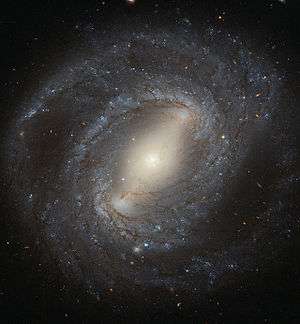NGC 4394
Coordinates: ![]()
| NGC 4394 | |
|---|---|
 NGC 4394 taken by Hubble Space Telescope.[1] | |
| Observation data (J2000 epoch) | |
| Right ascension | 12h 25m 55.624s[2] |
| Declination | +18° 12′ 50.13″[2] |
| Redshift | 0.003075[3] |
| Helio radial velocity | 922±4 km/s[4] |
| Galactocentric velocity | 886±4 km/s[2] |
| Distance | 39.5±2.9 Mly (12.1±0.9 Mpc)[4] |
| Group or cluster | Virgo Cluster |
| Apparent magnitude (V) | 10.9[4] |
| Apparent magnitude (B) | 11.9[2] |
| Absolute magnitude (V) | -20.49[4] |
| Characteristics | |
| Type | SBb / (R)SB(r)b[4] |
| Size | 41.2×38.8 kly (12.7×11.3 kpc)[4] |
| Apparent size (V) | 3.6′×3.2′[4][3] |
| Other designations | |
| NGC 4394, UGC 7523, PGC 40614, MCG+03-32-035[3] | |
NGC 4394 is a SBb barred spiral galaxy in the constellation Coma Berenices and is situated about 39.5 million light-years (12.1 megaparsecs) from Earth.[4] It was discovered on 14 March 1784 by the German–British astronomer William Herschel.[3] It is a presumed companion to the lenticular galaxy M85 / NGC 4382, which lies 8 arc minutes away.[3] It is also a member of the Virgo Cluster.[5][6]
References
- ↑ "Hubble spies NGC 4394". Retrieved 4 May 2016.
- 1 2 3 4 "Search Results for NGC 4394". Retrieved 4 May 2016.
- 1 2 3 4 5 "The NGC/IC Project for object NGC 4394". Archived from the original on 20 May 2012. Retrieved 5 May 2016.
- 1 2 3 4 5 6 7 8 "NASA/IPAC Extragalactic Database (NED) results for object NGC 4394". Retrieved 5 May 2016.
- ↑ "Detailed Object Classifications". ned.ipac.caltech.edu. Retrieved 2017-08-25.
- ↑ "The Virgo Cluster". www.atlasoftheuniverse.com. Retrieved 2017-08-25.
| Wikimedia Commons has media related to NGC 4394. |
This article is issued from
Wikipedia.
The text is licensed under Creative Commons - Attribution - Sharealike.
Additional terms may apply for the media files.